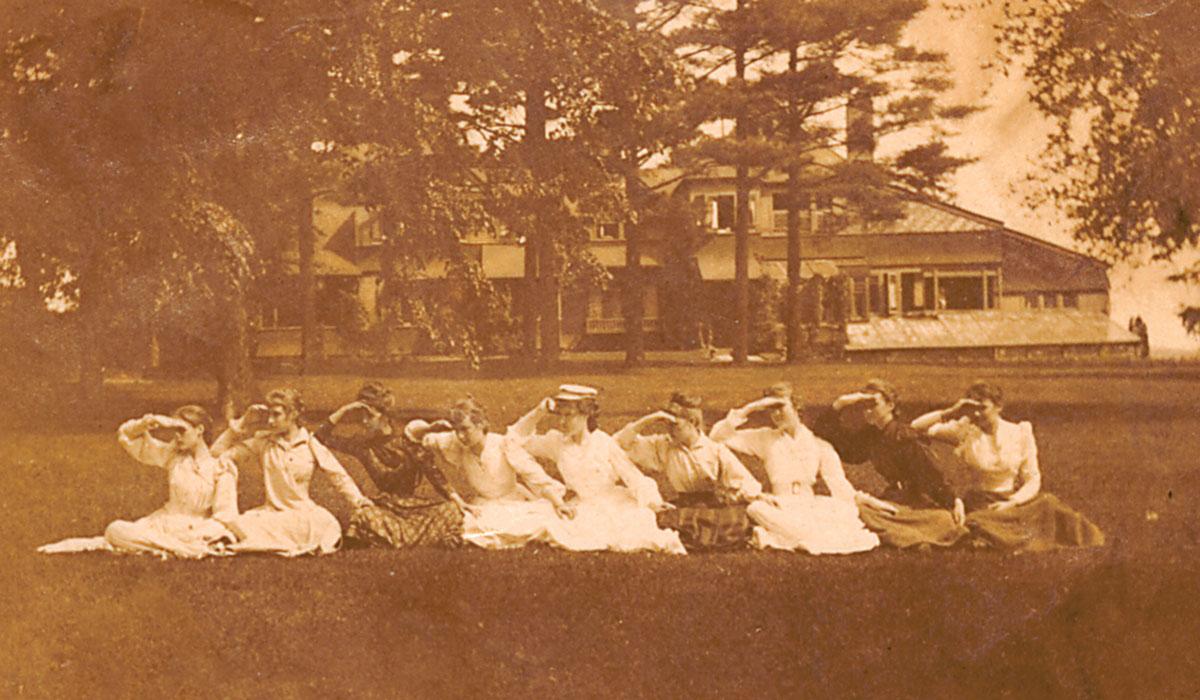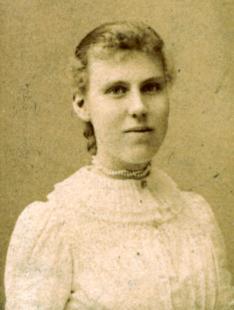“That our daughters may be as corner stones, polished after the similitude of a palace.”
— Psalms 144:12, the motto of Mount Holyoke College
Last time, in preparation for the great celebration She Roars, in honor of Princeton’s alumnae and their place in the world of 2018, we took a look back 50 years at the admirably thorough job done by the Goheen administration and the Patterson committee, once the University finally got around to realizing that undergraduate women deserved a place at the table.
The huge turnout for the conference — about 3,400 alums attending — raises our admiration here at History Central, but also, to be honest, a few of the galloping guilts, including one of those unsatisfying historical footnotes that would simplify life if it just vanished. No such luck; the saga of Evelyn College will forever remain preserved in the actual footnotes of the Patterson report, wherein Professor Gardner Patterson, a fine writer, brusquely dismissed it as a “timid involvement.”
I’ve always assumed that most alums vaguely knew about Princeton’s coordinate women’s college of days long past. But having recently tested the waters around campus, I find almost no Princetonians younger than 50 who have any idea it ever existed. In the 1960s, when the coeducation battle raged, everyone on both sides knew there had been a bold experiment by the cutting-edge Presbyterian thinkers supporting women’s education in the time of President Francis Patton. A 1968 Prince article by my dear friend Stan Pieringer ’70 is one of the better on Evelyn written in the 20th century.
READ MORE She Can Do It!
At She Roars, alumnae return to campus to discuss — and celebrate — their role in society and at Princeton
But the Patterson report, which meticulously set up the detailed image of a coordinate women’s school (a la Radcliffe, Pembroke, or Barnard) as an interim option for Princeton women, and then proceeded to demolish it with logic as ruthless and blunt as only an erudite economist can supply, pretty much focused on the hows of full coeducation, having retired the trophy for exhausting the whys. And the peculiar tale of Evelyn College, the Pride of Queenston, began to fade into the mists of time.
In 1887, women’s colleges were hardly a novelty. They had been around in various shapes for more than a century, and as real operations since Mount Holyoke started in 1837, four years after Oberlin started coed classes. Radcliffe, the first full-blown coordinate college, opened in 1879, and closer to home, Bryn Mawr began in 1885, so for those with an interest (which didn’t seem to include many at Princeton), the time was right. In fact, if there were others besides former Princeton professor Rev. Dr. Joshua Hall McIlvaine 1837, his family, and a precious few of his alumni friends, it wasn’t apparent. So when they came to Princeton President James McCosh for help, it appeared ludicrous. But just to reinforce suspicions of divine intervention, McCosh (who had also taught black students in graduate courses, remember) pushed an aid package through the trustees. It included no money, but effectively gave Evelyn carte blanche with the Princeton faculty and even the use of various labs for parallel science courses.
Somehow, professors who even then were legendary, including Allan Marquand 1874, the creator of the art department, and Charles Young, the world-renowned astronomer nicknamed “Twinkle” by his students, dug right in to teach the ladies. President Patton, McCosh’s successor, was known for doing as little as possible, but very ineffectively. He not only let the deal ride but joined the Evelyn board. Young professors such as Woodrow Wilson 1879, Henry Burchard Fine 1880, and John Grier Hibben 1882 *1893 taught the women, too. To be fair, McIlvaine did hire a scant few dedicated teachers, including Helen Magill White, the first woman Ph.D. in the country. By 1896, when Harper’s Bazaar did a gung-ho profile of Evelyn, earnestly pitching for funds for the little college, it was seriously comparing it to Radcliffe, Pembroke, and Barnard, although its student body never grew above 50, principally daughters of Princeton faculty and sisters of Princeton men.
With its major curricular expenses absorbed by Princeton, Evelyn was able to operate on less than a shoestring for its 10 years of quizzical but well-regarded existence. McIlvaine, who for some reason came up with this whole thing at age 72, named the little coordinate institution for John Evelyn (you knew it couldn’t be a woman, right?), fellow of the Royal Society and sort of a minor-league version of Samuel Pepys, who documented the 17th century in London. According to McIlvaine, Evelyn (EEV-lin) had been learned and modest. The college had colors, orange and white, and a physical home, a huge rented mansion that still exists at the end of what is now Evelyn Place, a block away from the corner of Nassau and Harrison Streets, an area that was known in Colonial times as Queenston (between Princeton and Kingston, get it?). The dorm, more of an issue than the classrooms to the local constabulary, which had to protect virtue, was on Nassau Street a block away.
The protecting virtue part, apparently something of an issue throughout the 10 years, involved the Princeton undergrads pursuing the Evelyn women, often to distraction. They set fire to the college chicken coop behind the dorm in order to rush in and courageously save the women from the roasters (the romantic term for this in the literature is “arson”). They would stand outside the dorm and chant “Eva, Eva, l-y-n, Eva, Eva, let me in” and other analogous pleasantries. Supposedly there were trysts of varying degree in a few vacant properties in town, and despite Harper’s high-minded women’s-lib rhetoric, the image persisted of Evelyn students as being principally on the make for a husband.
You couldn’t refute that from the scrapbook (ensconced in the University Archives) of Josephine Read Curtis, Evelyn Class of 1892, from Troy N.Y. It’s a 12-by-16-inch tribute to the mores of the Gilded Age; in dozens of pages of engraved embellishment it documents innumerable teas, balls, and receptions across the Northeast (and even a Pennsylvania Railroad ticket to Troy), which leads to the question of when she might have been in class. It also solves a number of burning historical questions I had never thought to ask, to wit: “How did you write your name on a young lady’s dance card at the prom?” Answer: There were tiny pencils, much smaller than the tortuous things they inflict on you at the golf course, tied with lovely ribbon to the card.
Also in the scrapbook, there is name-dropping — Patton’s wife invited Curtis to tea at Prospect to meet the fabled Isabella McCosh, wife of the president emeritus and namesake of the infirmary that was the first monument to a woman at Princeton. There is a program for the laying of the McCosh Infirmary cornerstone in 1892. Curtis included multifarious events with the boys: In addition to the infinite dance cards, there is a full scorecard from the Princeton/Yale baseball game of June 13, 1891 (Princeton 5, Yale 2, of course), the program from the very first Triangle Show, Po-ca-hon-tas, in 1891, and tellingly a ticket to Princeton’s Class Day on Cannon Green in 1892. Among the seniors was Edward Dickinson Duffield 1892, son of a famous Princeton professor, who would go on to be a wealthy lawyer, chair of the trustees, and even temporary president of the University in 1932. They were married five years after his graduation.But to be fair to all concerned, even a glimmer of an educational opportunity, offered beneath the layers of trappings of the upper crust, clearly had its impact on the folks who inhabited Evelyn over its 10 years. Cyrus Fogg Brackett, the Joseph Henry Professor of Physics and science teacher extraordinaire, proclaimed his “very great satisfaction with the attention the young ladies have given in the classroom, and with the progress they have made with consecutive and logical thinking.” And to be fair to our social correspondent Josephine Read Curtis Duffield, her course notebooks (also residing in the Archives) in the sciences, English literature, and French show her as a perfectly alert consumer of the rote learning of the time, reflecting comfort with the materials and no sign of hesitance or confusion in any of them. And who among us today took astronomy, chemistry, physics, psychology, and zoology? Just saying.
Nonetheless, when McIlvaine died at 82 in 1897, his wife and daughter and their paper-thin operations seemingly had no redress but to close Evelyn College in a hurry. Whether the persistent rumors of profligate adventures (or the lack of a chicken coop) played a part is difficult to say all these years later. The Panic of 1893 had mired the country in recession, there were but 14 students left, and the finances were untenable in any case. But let me note this: Simultaneously, Professor Andrew Fleming West 1874 and trustee Moses Taylor Pyne 1877 (in the vacuum created by Patton) were raising piles of dough to run the glorious Sesquicentennial, where Princeton was renamed a University, and to build the grand new Pyne Library (now East Pyne). Neither name appears anywhere in relation to Evelyn, ever, and maybe that’s more telling than all the dance cards in New Jersey.


